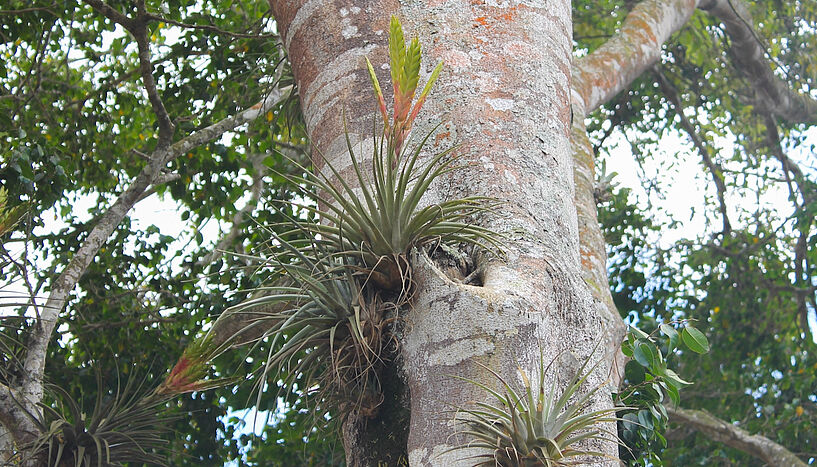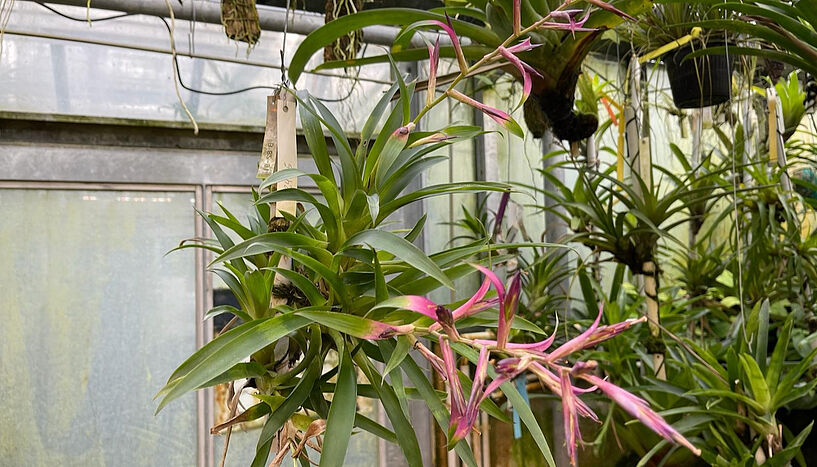Unlocking the Genetic Mysteries Behind Plant Adaptation: New Insights into the Evolution of a Water-Saving Trait in the Pineapple Family (Bromeliaceae)
30. April 2024Adaptation of the photosynthetic mechanism in air plants (Tillandsia) occurs through gene duplication
Researchers at the University of Vienna, along with collaborators from France, Germany, Switzerland and the USA, have achieved a major breakthrough in understanding how genetic drivers influence the evolution of a specific photosynthesis mechanism in Tillandsia (air plants). This sheds light on the complex actions that cause plant adaptation and ecological diversity. The results of their study are now published in Plant Cell.
Some plant species have evolved a water-saving trait called Crassulacean Acid Metabolism (CAM). CAM plants like most Tillandsia species – the most species-rich genus in the pineapple family (Bromeliaceae) – optimise their water use efficiency: While other plants normally open their stomata (tiny pores in their leaves) during the day to absorb carbon dioxide for photosynthesis, CAM plants do this at night and stash CO2 away for later use, helping them survive with less water. This trait evolved independently several times across the plant kingdom. However, the evolution of the complex genetic basis of CAM has remained elusive, making it a focus of research in evolutionary biology.
Gene Regulation is Key
In this study, the research team focused on a Tillandsia species pair exhibiting divergent forms of photosynthetis– CAM vs. C3 – meaning that the C3-species lacks the specialized adaptation to arid conditions. By using advanced techniques to study the plants' genetics and biochemistry – e.g. analyses of gene arrangements, molecular and gene family evolution, temporal differential gene expression and metabolites – they discovered that changes in gene regulation are mainly responsible for genomic mechanisms driving CAM evolution in Tillandsia.
Clara Groot Crego, Department of Botany and Biodiversity Research at University of Vienna and lead author of the study, explains: "Our findings reveal that while large-scale changes have influenced Tillandsia's genomes like other plants, the adjustment of how photosynthesis works mainly happens through how genes are regulated – not by changing the sequences that code for proteins." Key insights from the study, funded by the Austrian Science Fund (FWF) and the University of Vienna, include the identification of CAM-related gene families undergoing accelerated expansion in CAM species. This highlights the critical role of gene family evolution in generating novel variation that drives CAM evolution.
Into New Niches by Repeated Evolution
"CAM repeatedly evolved in different Tillandsia species and has accelerated their ability to colonize new ecological niches, serving as a key driver of the rampant speciation observed within this group," says Ovidiu Paun, Department of Botany and Biodiversity Research at University of Vienna and principal investigator of the study. "Our research highlights the potential importance of genetic innovation, beyond mere base pair changes, in driving ecological diversification", Paun adds.
Thibault Leroy, principal investigator from INRAE Toulouse, France, emphasizes that this study has implications beyond basic science. "Understanding how CAM evolved can help develop strategies to make crops more resilient to water shortages and cope with climate change."
The research will be extended across more species of this and other plant groups in the framework of a newly collaborative project jointly funded by the Austrian Science Fund (FWF) and the French National Agency for Research (ANR).
Original publication:
CAM evolution is associated with gene family expansion in an explosive bromeliad radiation. Clara Groot Crego, Jaqueline Hess, Gil Yardeni, Marylaure de La Harpe, Clara Priemer, Francesca Beclin, Sarah Saadain, Luiz A. Cauz-Santos, Eva M. Temsch, Hanna Weiss-Schneeweiss, Michael H.J. Barfuss, Walter Till, Wolfram Weckwerth, Karolina Heyduk, Christian Lexer, Ovidiu Paun, Thibault Leroy. Plant Cell.
DOI: 10.1093/plcell/koae130
Pictures:
Fig. 1: Tillandsia fasciculata is one of the study species of this work. It performs an alternative form of photosynthesis called CAM, which allows it to survive as an epiphyte in water limiting conditions. C: Ovidiu Paun
Fig. 2: Tillandsia leiboldiana grown in the bromeliad collection of the Botanical Garden of the University of Vienna. It is closely related to CAM-performing T. fasciculata, but in standard conditions it does not perform CAM itself. Instead it collects water in a tank-like structure that it forms with its leaves. C: Michael Barfuss
Scientific contact
Assoc. Prof. Ovidiu Paun
Department für Botanik und BiodiversitätsforschungUniversität Wien
1030 - Wien, Rennweg 14
+43-1-4277-54057
ovidiu.paun@univie.ac.at
Clara Groot Crego, MSc BSc
Department für Botanik und BiodiversitätsforschungUniversität Wien
1030 - Wien, Rennweg 14
+43-1-4277-54040
clara.groot.crego@univie.ac.at
Further inquiry
Mag. Alexandra Frey
Media Relations ManagerUniversität Wien
1010 - Wien, Universitätsring 1
+43-1-4277-17533
+43-664-8175675
alexandra.frey@univie.ac.at
Downloads:
20240430_Paun_Abb1_02.jpg
File size: 2,2 MB
20240430_Paun_Abb2_02.jpg
File size: 411,58 KB


